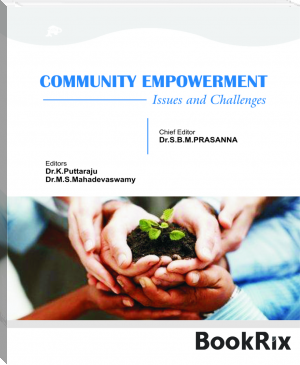Community Empowerment by Dr. SBM Prasanna, Dr. K Puttaraju, Dr.MS Mahadevaswamy (books under 200 pages TXT) 📕

Book online «Community Empowerment by Dr. SBM Prasanna, Dr. K Puttaraju, Dr.MS Mahadevaswamy (books under 200 pages TXT) 📕». Author Dr. SBM Prasanna, Dr. K Puttaraju, Dr.MS Mahadevaswamy
Sustainability Management System(SMS): Developing a frame work to ensure that environmental, social and economic concerns are consider in tandem throughout organization’s decision-making processes. Organization should start by identifying and prioritizing sustainability aspects and impact.
Lifecycle Assessment: Product design is critical. Gone are the days where immediate product was the only thing that the matter, without any given thought to its afterlife. A scradle-to-cradle approach exhibits a company’s creativity and innovation and can, consequently improve its bottom line.
Sustainability /CSR Reporting: CSR reporting has increased in popularity over the past few years, increasing government regulations as well as self-regulation by forward-thinking companies. It is important that consumer base has easy access to an organization’s and latest and greatest efforts, in a way that does not minimize what they are doing.
Sustainability Branding: Transparency is a key in sustainability branding. For e.g., Clorox Green Work when endorsed by the Sierra club, can able to capture 42% of the market share in their first year.
Indian Examples of CSR Initiatives
As estimate 100 corporate foundations and 25 foreign firms are involved in CSR activities in India, but statistics on input and output are elusive. Companies, continue to rely on different models to earmark its social expenditure, making it difficult to measure the overall impact.
Here are a few illustrations of the different social responsibility functions that Indian companies typically performed:
Reliance Industries and Two Group firms-Tata Motors and Tata Steel-are the country’s most admired companies for their corporate social responsibility initiatives, according to a Nielsen survey released in may 2009. Tata steel Ltd., which runs an 850-bed hospital and rural projects in 800 villages around Jamshedpur, spends an average of
Rs-150 crore as a part of its annual revenue expenditure.
As a part of its Corporate Service Corps (CSC) program, IBM has joined hands with the Tribal Development Department of Gujarat for a development project aimed at upliftment of tribal in the Sasan area of Gir forest.
The financial services sector is going green in a steady manner. With an eye on preserving energy, companies have started easing the carbon footprint in their offices. The year 2009 witnessed initiatives including application of renewable energy technologies, moving to paperless operations and recognition of environmental standards. Efforts by companies such as HSBS India, Max New York Life, and standard Chartered Bank have ensured that the green movement has kept its momentum by asking their customers to shift to e-statement and e-receipts.
State-owned Navratna Company, coal India ltd., (CIL) invested U.S. $67.5 million in 2010-11 on social and environmental causes.
Public sector aluminum company NALCO has contributed U.S.$3.23 million for development work in Orissa’s Karafuto district as part of its Corporate Social Responsibility (CSR).
A V Birla Group is involved in social and economic development of communities.
BHEL has contributed to the development of quality of life in rural areas, health care and family welfare, adult education, etc.
Reddy’s Labs promotes education, livelihood and community development.
Escorts Ltd., has worked for farm mechanization, agriculture development, healthcare, etc.
Hindustan Unilever focuses on health, empowerment of women, and education of special children. Unilever is using microenterprise to strategically augment of the penetration of consumer products in rural markets.
ICICI Bank’s focus areas are elementary education, universal access to financial services, etc.
Infosys through its Infosys Foundation provide assistance to social development, art, culture, school, libraries, for higher education and research.
ITC Ltd., is socially active in rural development especially in the areas of agriculture, culture, sports and pollution control. ITC have made farmer development a vital part of its business strategy and made major efforts to improve the livelihood standards of rural communities.
Steel Authority of India Ltd., (SAIL), the country’s largest steel company, contributes to the sector of agriculture, industry education, healthcare, dairy, poultry, fisheries and drinking water supply. The company spent Rs-100 crore on CSR last year, this was 2% of its profit after tax, exclusive of dividend tax.
IT companies like TCS and Wipro have developed software to help teachers and children in schools across India to further the cause of education.
Pharmaceutical Company Jubilant Organosys Ltd., already runs an anti-tuberculosis program with the government of Uttar Pradesh. Apart from schools and hospitals that are run by trusts and societies, the government, too, is exploring to widen the scope of public-private partnerships to build and maintain schools and hospitals in return for fixed annuity payment.
Conclusion:
It is concluded that CSR is about business, government and civil society collaboration with the bottom line is the achievement of win-win situation among three entities. From social point of view, CSR should be benefit community because the latter has a complex structure as it consists of individuals with varies levels of control of resources physically and intangibly. The analysis on the theories allows the understanding of that goes beyond its traditional meanings; therefore CSR necessitates a multidisciplinary approach in its perspective and practice. Since the current meaning of CSR is complex, knowing the theories allows scholars to have a better understanding about corporation society relations, in which theories and practices of CSR are influenced by numerous economic and non economic as well as internal and external forces.
References :
www.careers.ed.ac.uk ,
www.findmehere.com
REVIVING A FORGOTTEN SPORT TOWARDS COMMUNITY EMPOWERMENT
ANJAN KUMAR B J
Physical Education Director, Govt. First Grade College, Sulibele, Hosakote Taluk, Bangalore Rural District
ABSTRACT
India is a home for several distinctive sports both individual & collective. Our history & heritage is replete with several such sport events which instilled a spirit of good sportsmanship as well asspirit of unity. One such sport event which is known for its rarity & uniqueness is Mallakambha is a distinctive sport which has uniqueness & rarity besides it has been a very good community sport. Mallakambha has been considered as a traditional sport with flavors of promoting excellent health & gymnastic temperaments.But this has been long neglected as modern sports took over . youth were attracted towards popular games & this customary practice of Mallakambha was almost forgotten , But several attempts have been made to revive this rare fusion sport. This paper argues the immediate necessity to revive this sport with a dual dimension of making our youth healthy & continuation of our rich cultural heritage.
Keywords:Mallakambha , heritage sport , health conscious youth . community empowerment, reviving through governmental policies
Mallakambha is a distinctive sport which has been known for its promotion of body balance , harmonization , & yoga . Mallakambha is a synchronization of yoga & gymnastics. It is keeps one mentally fit & physically fit. It combines two popularly gaming patterns which can be collective as well as individual game Government is making several attempts to make this sport survive for posterity
HISTORICAL BACKGROUND
Mallakambha sport is almost 1000 year old. It has a long history It has been mentioned in Sanskrit texts it is combination of roping & swinging .Mallakambha is mentioned in Manasollasa , a great literary composition under western Chalukyas written around 1135 AD.
MYTHICAL INSPIRATION
The legacy about Mallakambhasport is that lordHanuman is personified through this sport. Lord Hanuman whowas famous for his valor, will power, mightiness &heroism is personified here. The pole is not touched by feet as it is disrespectful to touch with feet it is always touched through toe fingers. The rope is synonymous with the tail of Hanuman which is not only powerful but also wades through tough times.Thus sport perceivesgallantry , attentiveness, concentration, & above all willpower. All these characters were reflected through Lord Hanuman in epic drama Ramayana.
TYPES OF MALLAKAMBHA
Malla means a gymnast &kambha means a pole.The credit of popularizing the modern version goes to master Balambhatta dada deodhar who infused a new life into this historic sport activity
Pole Mallakambha
Hanging Mallakambha
Rope Mallakambha
MALLAKAMBHA FEDERATION OF INDIA
Promoting this Mallakambha acrobatic game was bit tougher. Mallakambha was presented in modern Olympics way back in 1936. Indian government established the Mallakambha federation for rejuvenating thus sport.
GOVERNMENTAL ENDEAVORS TO REVIVAL
There have been several attempts to revive this heritage sports through government .
Mallakambha Federation of India has been set up to revitalize this sport o modern lines.
State of Madhya Pradesh has decided to declare Mallakambha as the state sport
In the state of Maharashtra Mallakambha clubs & coaching centers are prominent by their presence.( Report Of The Sports Authority In India - Ministry Of Youth Affairs & Sports 2012).
Several states have been reviving this activity with new conceptions & fusions.( Report Of The Sports Authority In India - Ministry Of Youth Affairs & Sports 2010).
Several schools in Maharashtra , Uttar Pradesh , Madhya Pradesh have taken this sport seriously & have instituted Private clubs to propagate this event.
Several states are thinking of considering this sport activity as Public Private enterprise.(Report Of The Sports Authority In India - Ministry Of Youth Affairs & Sports 2010).
There are enthusiastic NGOs who can adopt this sport activity into a new fusion game as it happens in case of several rural sports.( Report Of The Sports Authority In India - Ministry Of Youth Affairs & Sports 2009).
Community will be encouraged to involve themselves in this activity as it supports them with health awareness, knowledge about heritage & brotherhood bondage .
CONSIDERATIONS FOR IMPROVEMENT-
Government should support Mallakambha sport at national level sporting events.
Government Policy should motivate investment in this sport by strengthening capabilities, technology transfer, promotion, educating the rural people about the benefits of this sport on a wider scale.
Youth Sport commissions should be sent to other countries to popularize this sport
Mallakambha should be demonstrated at national & international level sport meets
Mallakambha should be demonstrated at schools & colleges in local level
Using short films, documentaries , cartoon network , animation technology , community radio network , internet , etc this activity can be made to rejuvenate.
An incentive for Mallakambha coaches with exemplary credentials stimulates them to work towards making it further deep rooted.
Honoring Mallakambha sport with promotion through national level honors, medals & cash prizes will draw attention of the youth
Allocation of budgetary funds to this sport is the need of the hour
This sport should be supported through funding through NGO collaboration
Promotion of this sports with sponsorship from corporate agencies can be considered
Cash rewards for young Mallakambha achievers should be announced annually.
Rural tourism can be promoted through this sporting event.
State level / district level Mallakambha encouragement programs should be conducted
Mallakambha can be made more skill-oriented through further fusions.
Long term training programs for training good child & adolescent followers can be thought of.
To integrate health and family welfare programmes at national, State, district, and block levels, this art of Mallakambha can be considered .
The added benefits of this sport to health & empowerment , the community can be benefitted by popularizing this sport in melas, fairs , annual religious ceremonies,cultural festivals, film shows, etc .
This rare sport activity can also be made a part of rural tourism as is the case with several folk culture.
It can be made as a high promotion of sustainable tourism practice ( Report of the Scheme For Rural Tourism Development –Ministry Of Tourism 2013 ).
It can be made to contribute to the revival of lost folk art and handicrafts which are on the fringe of extinct.
It is can be made an ideal and natural method of empoweringrural and urban communities.
India, being a multi cultured nation can embark upon utilizing the assistance from these rare sports activities & improve its prospects in rural community development research.
The concept that sports as an alternative education is being perceived across the globe because of its potentialities. It’s function as a tool of providing socio- cultural knowledge & community empowerment is being conjectured. That this sport can become an alternate educative system can also be considered .( Report Of The Sports Authority In India - Ministry Of Youth Affairs & Sports 2009).
CONCLUSION
Mallakambha is thus a fusion game which has acquired modern looks with lots of acrobatic movements which helps physical fitness to all parts of body besides it helps linear body movement which improves concentration & attentiveness. Youth can consider learning this skill & aptitude to improve their physical fitness level& health maintenance .But this sport needs for revitalization through inclusion in National & international level





Comments (0)